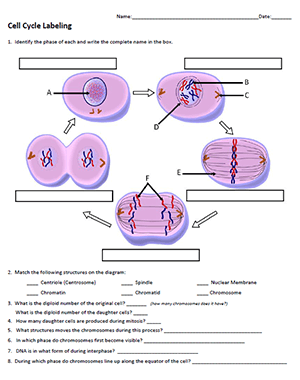
This worksheet was created for freshman level biology and is a simpler version of a worksheet I use in the advanced classes showing the cell cycle. The image shows a cell in interphase, prophase, metaphase, anaphase, and telophase. Students label each phase and then identify structures within the cell that are important for cell division, like the centrioles and spindle.
Questions then ask students to determine the diploid number of the cell (by counting the chromosomes) and identifying phases by description alone.
I usually have students attempt to do this on their own and then project it to the whiteboard and have a student fill in the answers so students can check their work.
Mitosis can be a difficult topic for freshman because it requires them to visualize and model a process that is not easy to view. Even if you provide microscope slides to view, like an onion root tip, most of the cells are in interphase and real cells will not look exactly like the model.
The key to helping your students learn this process is PRACTICE. Students will need a lot of diagrams, images, and models. I print and laminate images of mitosis and have students step in front of the class and arrange themselves in the correct order. Students can even print a smaller version of this image and make flash cards to help them study the correct order.
Grade Level: 7-12
Time Required: 10-15 minutes
HS-LS1-4 Use a model to illustrate the role of cellular division (mitosis) and differentiation in producing and maintaining complex organisms.

